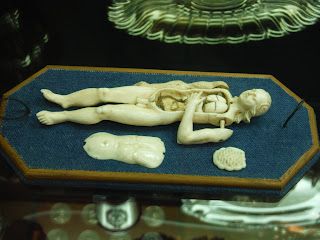Today was a very exciting day as we descended into the Wieliczka (Vyeh-lee-ch-ka) salt mine! The mine is located in the small town of Wieliczka, about 10km from Kraków. This salt mine was established in the 13th century and was manned by a continuous line of miners, as jobs were passed from fathers to sons. The main production of table salt stopped in 2007, but small quantities are still harvested from evaporated brine (approximately 15,000 kg a year) making this probably the longest operating company in Poland. Our descent into the mine started with 380 steps down to the first level.
Due to the damp and salty conditions underground, the reinforcing structures had to be made of wood instead of metal. These conditions were great for preserving the wooden supports. Below is a picture of some of the oldest wood in the mine. In this particular case, a flood caused some salt buildup on the wood.
All throughout the mine, the walls and floors are solid rock salt. During the tour we were encouraged to lick the walls to confirm their saltiness...it's true! In some places there are salt formations like these, called cauliflower salt. Salt from the mine was qualified based on its purity, ranging from impure "green salt" to 99.9% pure "eagle salt" which was destined for royal use.
Throughout the mine, there are many scenes depicting legends of Wieliczka. These carvings were made directly into the salt. Older statues were often done by miners, while some carvings are from modern artists. All the grey stone-like material you can see is actually rock salt!
To move the massive quantities of salt harvested from the mine, there were many wood and rope-based winch systems. The earliest ones were man-powered, while later the winches were powered by horses, who stayed down in the mine for 20 years at a time :(
These carvings show gnomes working away in the mines. As legend has it, the gnomes worked through the nights, finishing the jobs of lazy miners.
This is the largest and most beautiful chapel in the mine, the Chapel of St. Kinga. Kinga is the local patron saint of polish miners. The majority of the carvings in the chapel were done by three miners over the course of many years and depict various religious scenes. The miners were very religious workers and would pray before work each day. One interesting feature of the chapel is that the tiled floor is actuially just the underlying salt floor with tile shapes carved into it. This detailed work took over a year to complete. The chandeliers hanging in the chapel, like those throughout the mine, are made of "eagle salt", the purest kind of salt.
This is the second tallest chamber in the mine (31m). The size is breathtaking, as is the wooden support structure. The wood was often painted white because it offered some fire protection, and was better at reflecting light from the small lanterns. By the end of the tour we had reached the third level of the mine (135m below ground) which is as deep as tourists can visit. The whole tour led us through only 1% of this enormous mine. We returned to the top via elevator.
This is a souvenir photo taken by a camera in the mines...
Back in Kraków, we returned to
The museum consisted of the library, the dining hall, several apartments, the treasuries, and the Copernicus room. In the library we saw some old furniture and implements, such as this reading wheel and the Copernicus astrolabe.
On the left is a view of the library, with the sky painted on the ceiling so the scholars never had to go outside (just an assumption of ours...). This is a cool looking spiral staircase in the dining hall.
The treasury and Copernicus room had some interesting pieces, like this anatomical model and another one of Copernicus' astrolabes, which were either donated to the University, or belonged to previous inhabitants. Among the treasures were a Nobel prize, an Oscar, and an Olympic gold medal from Athens 2004.
As we were leaving the museum, we caught the end of the courtyard clock chiming a melody.


















No comments:
Post a Comment